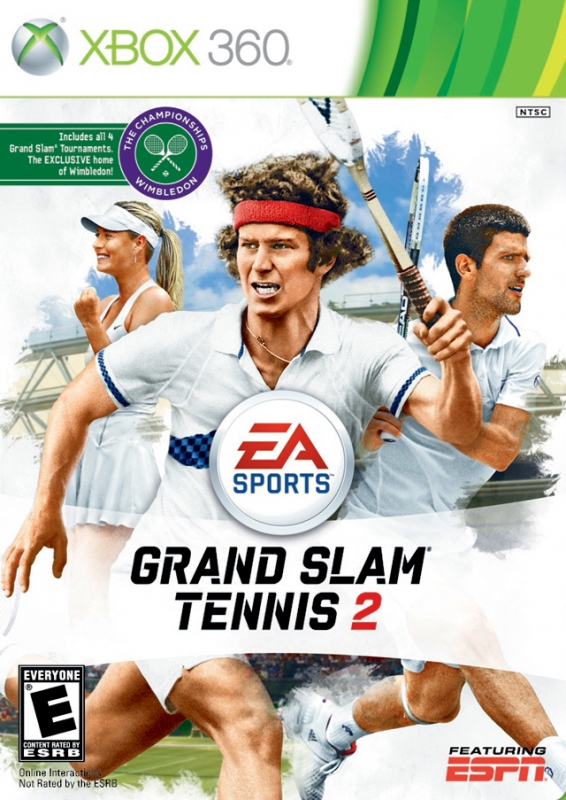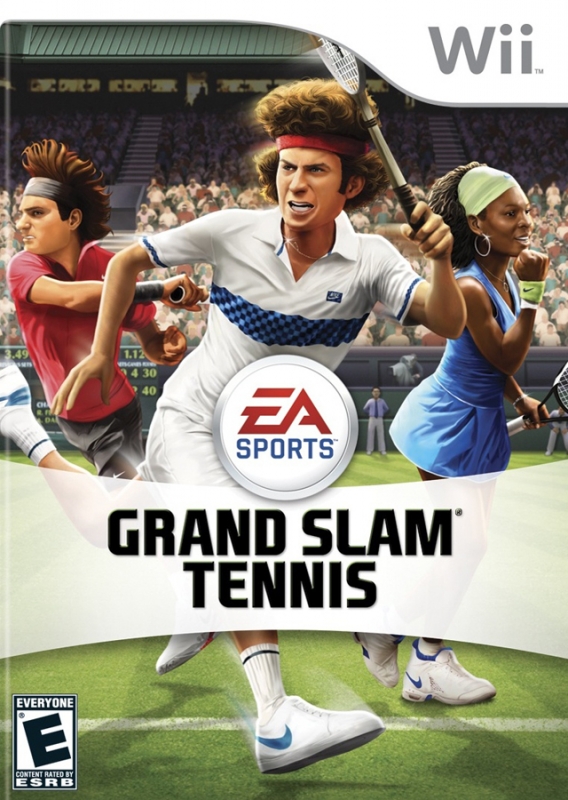
Grand Slam Tennis 2 - Review
by Craig S , posted on 09 February 2012 / 8,041 ViewsGet used to those words, you’ll be hearing them a lot.
Grand Slam Tennis is, to the best of my knowledge, the first tennis series to ever feature commentary. The superb commentary of John McEnroe (the best commentator and analyst in the industry) and Pat Cash in Grand Slam Tennis 2 makes it feel like you’re watching an actual match unfold. Their delivery is fantastic; their analysis is typically appropriate and in-synch with the on-court action; and their conversations give your tennis matches a real injection of personality and a much warmer atmosphere. In fact, when I briefly returned to Virtua Tennis and Top Spin after playing a few matches in Grand Slam Tennis 2, I was struck by how hollow and lifeless they felt in comparison - all because of the lack of commentary.
It’s a fantastic innovation for the genre, but it has one fatal flaw: there aren’t enough lines. Not nearly enough. Once you’ve heard John McEnroe wax lyrical about the benefits of hitting your shots deep for the umpteenth time, or telling you how tennis players ‘dream of being in this position’ every time you’re about to serve for the match, the whole house of cards will start crashing down; you’ll have reached the point where the commentary’s repetitiveness just starts to grate and you’ll soon mute it. And that’s a crying shame, because it really is great to listen to John McEnroe commentating on your match, just as he would a genuine match-up at Wimbledon or the US Open. The commentary direly needs more lines and, crucially, multiple variations of identical messages that are delivered frequently.
EA Sports are well known for their use of official licences, and that trend continues in GST 2. As well as the typically limited roster of stars – past and present - that you find in all mainstream tennis game nowadays (23 in total here), Grand Slam Tennis 2 also includes three courts for each of the four Grand Slam events (including Centre Court at Wimbledon, the Rod Laver Arena at the Australian Open, the Philippe Chatrier court at Roland Garros, and the Arthur Ashe Stadium at the US Open), ESPN replay and event features, and a great licensed soundtrack. The Grand Slam licences in particular are put to good use, with the courts being re-created wonderfully. Wimbledon being my ‘home’ Grand Slam, it was easy to appreciate the detail put into replicating the unique designs and atmospheres of those courts (No. 3, No. 1, and Centre Court); playing on one makes it look like you’re watching the broadcast of a live match.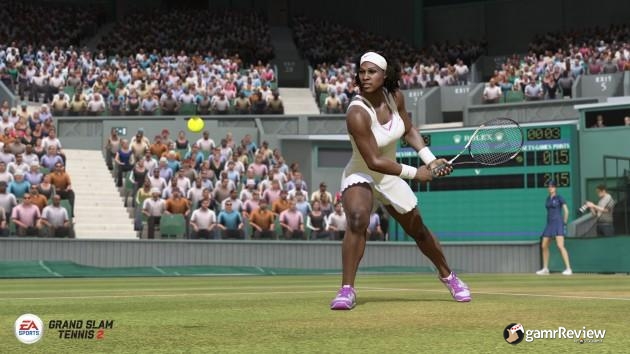
Or at least it would if the character models were more impressive - solid but unremarkable about sums them up, so there’s certainly room for improvement there. Player movements, in the case of the pros, are believable – the game effectively replicates the signature style of all of the licensed players, from Roddick’s mesmerising service style, to Federer’s distinctive backhand, and Murray’s all-round obnoxiousness – though there’s a tendency for characters to animate slightly rigidly when moving towards the ball, which is in contrast with the smooth and natural movements they make when they’re outside of the realm of player-controlled movement.
Elsewhere the presentation is slick but often cumbersome. The photos of pros form a stunning backdrop to the main menu, but the menus themselves are labyrinthine. And the loading times are simply outrageous - both for the matches themselves and within the menus. The game constantly stutters and stammers from one menu to another like a learner driver on his first outing, making something like the creation of your own custom player a true test of patience.
It’s always a good sign when you’re chomping at the bit to get back to a game after a break, and I did indeed get that feeling between my first two sessions with GST 2. There are two different control methods to choose from: ‘Total Racquet Control’, which almost exclusively uses the analog sticks, and a more traditional set-up using the face buttons. I played my first Grand Slam using the TRC method and, although at first it feels highly unintuitive, you soon get used to using different flicks of the analog stick to employ various shot types and determine their direction of travel. Switching back to the more traditional set-up for my second Grand Slam, I instantly felt more at ease – it simply feels more natural, and it’s certainly easier to pull off all of the different shots in your arsenal without having to worry about performing precise gestures with the second analog stick. And I can’t say that I noticed TRC being more precise either, despite the fact that this is presumably the primary reason for the emphasis placed upon it, so I stuck with the face buttons thereafter and I doubt I'll be alone in doing so.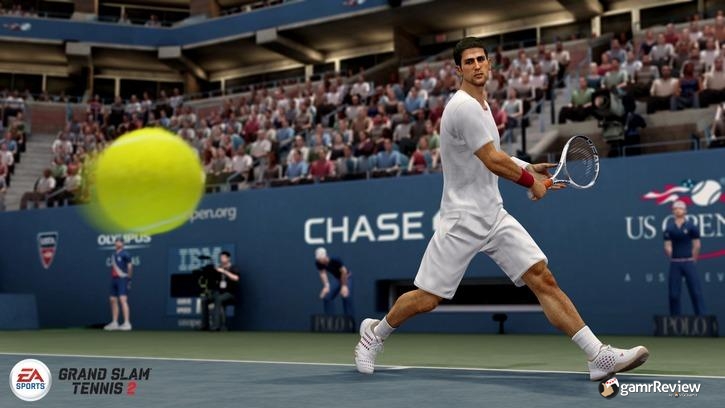
The gameplay is fast paced and addictive, but unfortunately it doesn’t win in a head to head with its competitors – gameplay-wise I’d definitely choose Virtua Tennis or Top Spin over Grand Slam Tennis 2. It’s more satisfying to power-up a shot and see the effects of doing so in those other two series than it is here, and GST 2 does nothing to fix certain perennial issues for a lot of arcade tennis titles, from the over-effectiveness of serve-and-volleying, to the ineffectiveness of lob and drop shots when used by the player against the AI, and the rarity of aces, net cords and out balls. The AI is pretty poor as well - on default settings it will simply miss easy balls half the time, which makes it far too easy to play against. For that reason I recommend starting your career either on the highest difficulty setting or one below that if you want any challenge whatsoever, or you’ll soon grow bored and be looking to start a new career on a higher difficulty setting.
Grand Slam Tennis 2 features the usual slew of modes you find in EA Sports titles: career, exhibition, tournament, ESPN Grand Slam Classics, and multiplayer (both local and online). The career mode isn’t too dissimilar from what you might be used to in, say, Virtua Tennis, but without the plethora of crazy mini-games. You work your way up the ranks, competing in minor tournaments, facing off in head-to-head rivalries, and completing training exercises, which allows you to improve your character before you head off to compete in one of the four Grand Slam tournaments. There’s also a career tennis shop, and the ability to change all of the little details on your character, from your head-wear to your shoes. This is all standard fare for the genre.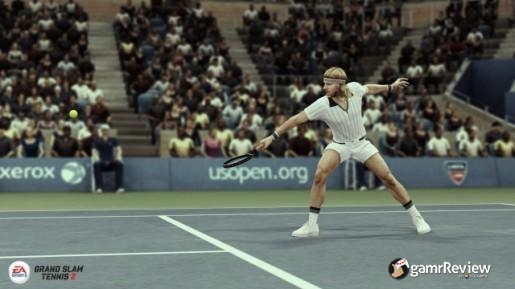
The mode which is most unique to GTS 2, though, is ESPN Grand Slam Classics, which allows you to unlock and play out some of the most famous Grand Slam finals and semi-finals, from the 80s to the current era of tennis. What’s especially neat about this mode is that the courts – particularly Wimbledon – have that slight ‘haze’ to them, which makes it look like you’re watching one of these classic matches being televised during a rain delay at Wimbledon. There’s also a brief introduction from Pat Cash for each match, giving you a little bit of background information for them. This is a mode that’s ripe for expansion in the all-but-inevitable sequel – a more detailed introduction from Pat Cash as the match commences, commentary that’s littered with references to the rivalries on display, and classics going back to the 50s, 60s and 70s would all be fantastic (black and white matches, anyone?)
If it has one, then Grand Slam Tennis 2’s Achilles’ heel is its gameplay, which lags behind what the competition already offers. But Grand Slam Tennis 2 is a good first entry for the series on HD platforms, putting EA Sports’ acquisition of key licences to stellar use. The commentary and analysis provided by Pat Cash and John McEnroe - among the sport’s most legendary and well-respected figures – is nothing short of a superb innovation for the genre, though one with plenty of room left for improvement going forwards.
This review is based on a PlayStation 3 copy of Grand Slam Tennis 2, provided by the publisher.
VGChartz Verdict
7.4
Good
























